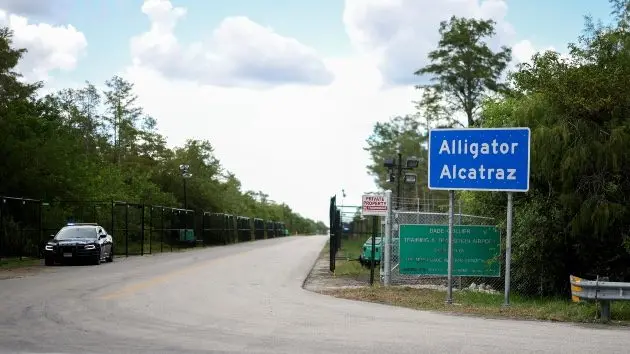(NEW YORK) — Known for the eponymous reptiles that inhabit the nearby swamps, the migrant detention center dubbed “Alligator Alcatraz” faces the possibility of being shut down over concerns about some of the area’s lesser-known inhabitants — the Everglades’ bats, panthers, and storks.
A federal judge on Wednesday is set to hold an evidentiary hearing over whether to block operations at the controversial facility because construction of the site allegedly bypassed federally required environmental impact studies.
The hearing — at which federal, state, and tribal officials are expected to testify — comes amid heightened scrutiny of the facility, which was once touted as a “one-stop shop to carry out President Trump’s mass deportation agenda.”
Immigrant advocates have alleged that detainees have endured inhumane conditions, including flooded facilities, spoiled food, and sweltering heat — and that they have limited access to their attorneys and are effectively housed in a jurisdictional “black hole.”
In a separate case challenging the legality of the facility, a federal judge ordered federal and state officials by Thursday to provide documentation showing which government or contractor is authorized to detain people at the sprawling complex. With state and federal officials dodging responsibility for the site, advocates have criticized the government for being vague about who runs the facility in order to bypass oversight.
While Wednesday’s hearing is limited to environmental issues — including impacts on the nearby Big Cypress National Preserve — the testimony is expected to shine a light on the operations of the facility and could result in a federal judge ordering the facility to be shut down until the required environmental impact studies are conducted.
“They have a lot of bodyguards and a lot of cops that are in the form of alligators. You don’t have to pay them so much,” Trump said last month when visiting the facility, adding that he’d like to see similar facilities constructed.
On Tuesday, the Department of Homeland Security announced a similar partnership — this time between the federal government and the state of Indiana — to construct a migrant detention facility dubbed the “Speedway Slammer.”
Located 50 miles west of Miami in the heart of the Florida Everglades, “Alligator Alcatraz” was quickly constructed over a matter of weeks, utilizing hundreds of tents, trailers, and other temporary facilities to potentially house more than 3,000 detainees. The facility was built on the grounds of the Dade-Collier Training and Transition Airport, a sparsely used piece of tarmac owned by Miami-Dade County.
The site was initially conceived in the late 1960s as part of an ill-fated plan to build the “Everglades Jetport.” As President Richard Nixon ushered in an era of new environmental protections — including the law now being used to challenge Alligator Alcatraz — the plan to build the site was scuttled, and the remaining tarmac was later used as an aviation training site.
“Now, history is repeating itself as [plaintiffs] once again must act to prevent destructive development in the heart of the Everglades ecosystem in the same location,” the current lawsuit says.
The facility sits next to the Big Cypress National Preserve and the Big Cypress Area, ecologically sensitive and protected areas that house threatened species including the Everglade snail kite, Florida panther, wood stork, and Florida bonneted bat.
Alligator Alcatraz also neighbors land leased to the Miccosukee Indian Tribe, including villages, a school, traditional hunting areas, and sacred sites. The Miccosukee Tribe joined the lawsuit last month, arguing that the facility threatens to damage nearby tribal villages.
“The hasty transformation of the Site into a mass detention facility, which includes the installation of housing units, construction of sanitation and food services systems, industrial high-intensity lighting infrastructure, diesel power generators, substantial fill material altering the natural terrain, and provision of transportation logistics (including apparent planned use of the runway to receive and deport detainees) poses clear environmental impacts,” the lawsuit said.
The environmental groups and the tribe that brought the case allege that the sprawling facility was built without the federal or state government conducting an environmental impact statement, which is required under the National Environmental Policy Act (NEPA) so the public and lawmakers can understand the impact of a project. They also argue that the government failed to get public input on the project.
The groups are asking U.S. District Judge Kathleen Mary Williams, an Obama appointee, to block ongoing operations at the facility until the government fully complies with NEPA and stop any ongoing construction.
Florida Department of Emergency Management executive director Kevin Guthrie, a named defendant in the lawsuit, has argued the facility is run by the state, which is not subject to NEPA regulations. He also claims that the site’s environmental impact is minimal because it was built on a location already serving as an active airfield.
The Department of Justice has also argued that the environmental groups cannot prove irreparable harm and that NEPA does not give a court the power to block the use of the facility.
Copyright © 2025, ABC Audio. All rights reserved.






